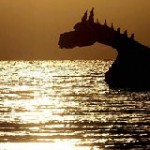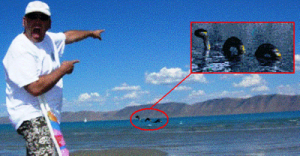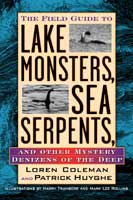Bear Lake Monster Revisited
Posted by: Loren Coleman on June 20th, 2010

Jerome Clark notes, regarding the following article:
The author of this piece creates what amounts to a conspiracy theory to advance a pseudoexplanation for the sighting reports, the most recent of which (that I’m aware of anyway) was in 2007. More likely, Joseph Rich exploited an already existing lake-monster tradition. Some reports are indeed intriguing, describing a cryptid mammal which in some ways recalls Australia’s fabled Bunyip.

_____
Idaho State Journal
Pocatello, Idaho
March 24, 1972
REAL OR NOT?
THE BEAR LAKE MONSTER
By J. PAT WILDE
Journal Correspondent
MONTPELIER – Western folklore abounds throughout the Rocky Mountain area. Unless one is a purist, all he has to do is accept the version that suits him best. The original may be harder to trace.
Often times we find the beginning steeped in the early legends of the area Indians. Such is the case of the “Lovers Leap” near Soda Springs. Occasionally, some prominent character of the time such as Jim Bridger or
“Peg Leg” Smith promoted a campfire yarn that caught on and became a legend of the area. Such local characters as “Six Shooter Sal” or “Cariboo Jack” can still be recalled by some residents.
But it is doubtful if any individual or legend, prefabrication of trapper or custom of Indian, gained as much prominence for an area or captured the attention of as many people as did the story of the Bear Lake Monster. It spewed forth from the fertile mind of Joseph C. Rich in the late 1860s and became a prominent topic of conversation for the next forty years.
As to why the monster was born, there is considerable controversy. Some authors say that Joseph, the versatile son of Bear Lake’s founding father, Charles Coulson Rich, was in love and created the monster to show his beloved, Ann Eliza Hunter of Salt Lake City, that life was just as exciting in the wilderness of Bear Lake as in the bigger metropolis.
Another claimed that the young lawyer had lost his father’s favorite mare in a poker game near Randolph, Utah, and felt the necessity of creating a suitable end to the animal that would satisfy his father’s skepticism.
Other theories state that his intention to test the gullibility of his fellow men was foremost in his mind or that the monster came into being merely to counteract the loneliness and boredom of the long Bear Lake winter evenings.
At any rate, the monster was “born” in the year 1868 and was exceeded in its growth only by the number of tales that were soon circulating about it. Young Joseph, himself, was not entirely responsible for all of them, but there is little doubt that he was the original author or the one responsible for bringing national recognition to the area.
During the remaining years of the century, especially from 1868 to 1875, such prominent characters of literature as John Collier’s Hell (Yellowstone Park), the explosive Mike Fink (half-man-half alligator from the
Mississippi), Paul Bunyan and his tall timber tales or Pecos Bill and his Grand Canyon folklore could do nothing but play second fiddle to J. C. Rich’s monster.
In its early days, Bear Lake was considered to be part of Rich County, Utah. Young Joseph was closely associated with the happenings of that state. He was an energetic 27, a budding lawyer and the assistant clerk of the Utah Legislature. He was also Rich County surveyor, successful businessman, church leader and quite an impressive writer. Best of all, as far as the monster was concerned, he was an established correspondent for the Evening Deseret News, top intermountain edition of that day. It was through this
medium that Rich chose to introducer the monster to the world outside of the Bear Lake Valley .
He began by hinting to his readers that something strange was going on in the beautiful blue lake and . “it is a mystery to me that all the leading journals of the world do not have journalists in the area to cover the
events . in fact,” he continued, . “I don’t know how people will tolerate their publication without.”
That was in the July 27, 1868[,] column. It continued to point out that an ancient Indian legend told of a monster that lived in the lake and annually carried to a watery grave at least a dozen maidens or braves. Rich said that for some reason the monster had not been seen in the area since the buffalo had left.
Early descriptions were vague. A serpent like animal, water spurting out of its head, with the capabilities of moving about on land with short muscular legs[,] sufficed.
Rich stated that since settlement in the valley (five years before) people had been seeing strange things on the lake but final “proof” was not obtained until a Mr. S. M. Johnson who lived on the east side of the lake at a place called South Eden offered a close-up description as follows:
“It had short sturdy legs, a serpentine like tail, ears that looked like bunches on the side of a head almost like a horse’s except for extended nostrils and a forked tongue that flicked in and out as it shifted its head
along.”
Soon other “verifications” developed. A Mr. Sleight and a Mr. Davis saw sides of the animal that were “at least ninety feet long – er – at least forty.” It was really quite difficult to tell just how long because of the
terrific speed at which it traveled.
More columns and more monsters followed. Soon there were four large ones and six small ones. Color had been added. It was brown or buff with huge spots on the large ones and when it kicked up its speed it sent waves shoreward that were three feet high.
Throughout the year of 1868 columns concerning it continued to pour into the “News.” Word spread to the Denver papers. The farther the word traveled the more skepticism arose. Not so at home. In the valley, the monster became a constant threat to wayward youngsters. Where later generations must have heard that the “boogey man will get you,” a suggestion that the monster had a special appetite for bad little boys and girls was often adequate to allow the youngsters to visualize their own tragic encounter.
Rich kept at his creation. One way or another, he was able to obtain reliable persons to make statements about the phenomena [sic]. At the end of one of his columns, he added a short note, supposed from his famous father, Apostle Charles C. Rich, noted colonizer and church man. It was addressed to Brother Cannon, editor of the Deseret News[,] and it said “I have talked with some of the parties in relation to the monster story and it is as Joseph has stated it. I am, yours truly, Charles Coulson Rich.”
Any doubt about the truthfulness of the monster seemed to fade with the statement. Who would doubt the word of such an honest and noted man as Charles C. Rich?
Once the monster was accepted there was little limit to the stories that developed. The hoax continued into the 1870s. The fact that government surveyors declared half of the lake and the valley to be in Idaho made
little difference. In truth, it may have enhanced an interest in the little community of Paris.
In a May 18, 1874[,] column postmarked Paris, Oneida County, Idaho, a letter written to President Brigham Young was printed which reactivated the hoax again. Wm. Budge, author of the letter, reported he and two brethren, William Broomhead and Milando Pratt[,] were returning from a LDS [Latter Day Saints, aka Mormon] conference in Richland County when they saw something in the water “one hundred yards ahead and about 25 yards from the shore.” This time the animal was described as “not more than six or eight feet long, face and head covered with fur or short hair of light spud color, wide spread eyes[,] and the whole face resembled that of a fox with a pointed snout.”
Budge concluded his letter to Brigham Young as follows, “We had an excellent opportunity to see what was above the water as the lake was perfectly still and visibility good. As there has been considerable interest excited in regard to the ‘Bear Lake Monster,’ I submit this description of what we have seen. Very respectfully yours, Wm. Budge.”
For several years plans were formulated on how to capture one of the monsters. Phineas Cook of Swan Creek thought it could be done with a giant hook attached to a huge buoy. The hook was to be “baited with a mutton or a young Indian.”
If any attempts were actually made to trap or ensnare one[,] no reference was available to this author.
As the years continued and the interest began to wane, Rich added to his hoax by creating a traveling writer known as “A. Monsterio.” Monsterio conveniently consented to allow his column to be published in the Deseret News, as well as his “other papers.” He wrote that he had traveled far to seek the “eighth wonder of the world, The Bear Lake Monster.”
Suddenly, to the surprise of many readers, Monsterio began to debunk the hoax in his column as he testified that “I could easily obtain the signatures of nearly 30 people to the effect that no such critter existed except in fertile imagination.”
Bear Lakers, now in support of their attention getter, defended their monster valiantly, but in vain. Monsterio continued his condemnation by stating in his columns, “Should I ever get close enough to the monster it is my intention to brand him J.C.R. on the left hip.”
There were those who suspected Monsterio and Rich were the same but all the partial confession did was create two battalions – those who believed and those who did not.
The trouble was, the monster never left. Perhaps it never will, because today, it has become of the finest examples of homespun western folklore. One hundred years later it still remains fresh to the minds of Bear Lakers and many an old timer would welcome the chance, like Samuel Taylor Coleridge’s “Ancient Mariner,” to spin a yarn.
Whatever Joseph C. Rich had in mind when he began the legend no one will ever know. He must surely be recognized for his creation. His authorship could, and perhaps should, be pointed to with pride. Only a small portion of literary work ever continues in popularity for a full hundred years.
Recognizing his popularity, the centennial committee for the Bear Lake County Centennial held in 1963 offered a competition for the best Bear Lake Monster stories in existence. Response was satisfying and an accumulation of them are [sic] now on record.

About Loren Coleman
Loren Coleman is one of the world’s leading cryptozoologists, some say “the” leading living cryptozoologist. Certainly, he is acknowledged as the current living American researcher and writer who has most popularized cryptozoology in the late 20th and early 21st centuries.
Starting his fieldwork and investigations in 1960, after traveling and trekking extensively in pursuit of cryptozoological mysteries, Coleman began writing to share his experiences in 1969. An honorary member of Ivan T. Sanderson’s Society for the Investigation of the Unexplained in the 1970s, Coleman has been bestowed with similar honorary memberships of the North Idaho College Cryptozoology Club in 1983, and in subsequent years, that of the British Columbia Scientific Cryptozoology Club, CryptoSafari International, and other international organizations. He was also a Life Member and Benefactor of the International Society of Cryptozoology (now-defunct).
Loren Coleman’s daily blog, as a member of the Cryptomundo Team, served as an ongoing avenue of communication for the ever-growing body of cryptozoo news from 2005 through 2013. He returned as an infrequent contributor beginning Halloween week of 2015.
Coleman is the founder in 2003, and current director of the International Cryptozoology Museum in Portland, Maine.









